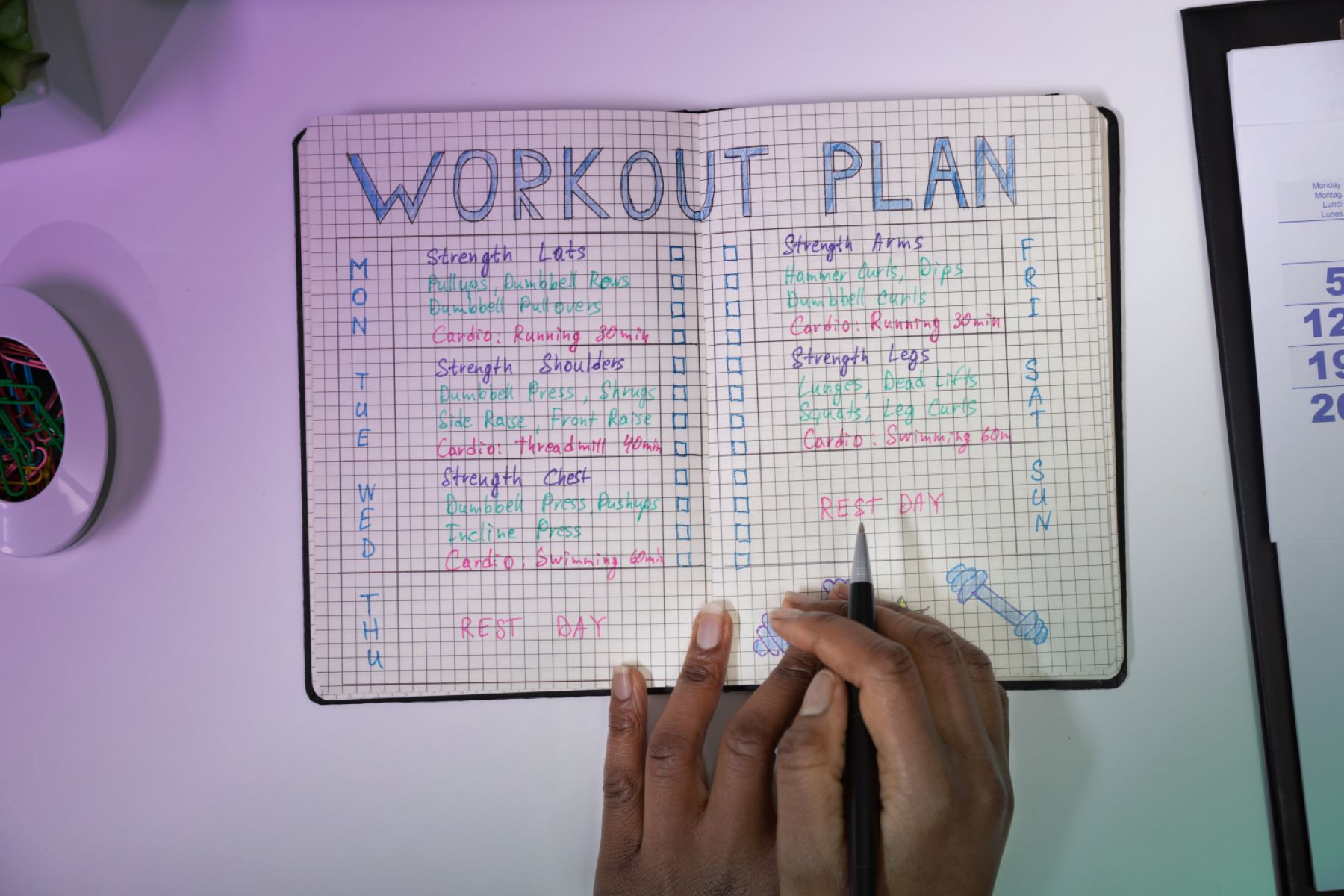

Featured
How To Workout Consistently
Modified: August 19, 2023
Achieve your fitness goals with our featured guide on how to workout consistently. Get expert tips and stay committed to your exercise routine for long-term success.
Introduction
Starting a workout routine is a great way to improve your overall health and well-being. Regular exercise can increase your energy levels, boost your mood, and help you achieve your fitness goals. However, many people struggle with consistency when it comes to working out. They find it difficult to stick to a routine and often give up after a few weeks or months. But fear not, because in this article, we will provide you with valuable tips on how to work out consistently and make exercise a lifelong habit.
Consistency is key when it comes to achieving results from your workouts. It’s not about doing intense workouts every once in a while; it’s about establishing a regular routine and sticking to it. By developing consistency, you will not only see physical changes but also experience the mental and emotional benefits that come with regular exercise.
In this article, we will guide you through the process of working out consistently, from setting goals and creating a schedule to finding an exercise routine you enjoy. We will also address the importance of creating a supportive environment, staying motivated, and overcoming challenges. Additionally, we will discuss how tracking your progress and celebrating milestones can boost your motivation.
We will also emphasize the importance of incorporating rest and recovery into your workout routine to prevent burnout and injuries. Lastly, we will explore the concept of habit formation and provide you with strategies to build consistency by making exercise a habitual part of your everyday life.
Whether you’re a beginner or have been on and off the fitness train, our tips and insights will help you establish a sustainable workout routine that you can maintain for the long term. So let’s dive in and discover how to work out consistently and reap the numerous benefits that regular exercise can bring.
Setting Goals and Creating a Schedule
The first step in working out consistently is to set clear and achievable goals. Having a specific goal in mind will give you something to strive for and maintain your motivation. Whether it’s losing weight, gaining muscle, improving endurance, or simply staying active, identify what you want to accomplish through your workouts.
Once you have set your goals, the next step is to create a schedule. Determine how many days per week you want to work out and what time of day works best for you. Consider your daily routine and commitments, and find a time slot that you can consistently dedicate to exercise. It’s important to be realistic and choose a schedule that you’ll be able to stick to in the long run.
Creating a visual schedule can help you stay organized and accountable. Use a calendar or a fitness app to map out your workout days and times. Treat these workout appointments as non-negotiable and prioritize them just like any other important commitment.
Additionally, make sure to set smaller milestones along the way to track your progress. These mini-goals will help you stay motivated and give you a sense of accomplishment. For example, if your main goal is to lose 20 pounds, set monthly targets of 2-3 pounds to keep yourself motivated and engaged.
Remember, setting goals and creating a schedule is not a one-time task. Revisit and reassess your goals periodically to ensure they are still aligned with your desires and aspirations. Adjust your schedule if needed to fit any changes in your routine or preferences.
By setting clear goals and creating a consistent schedule, you are establishing a foundation for your workout routine. With these tools in place, you’ll have a clear roadmap to follow, making it easier to stay committed and work out consistently.
Finding an Exercise Routine You Enjoy
One of the keys to working out consistently is to find an exercise routine that you genuinely enjoy. When you enjoy the activities you’re doing, you’re more likely to look forward to your workouts and stick to your routine. Here are some tips to help you find an exercise routine that suits your preferences:
1. Explore Different Activities: Don’t be afraid to try out various types of exercises and physical activities. From cardio workouts like running, swimming, or dancing to strength training exercises like weightlifting or Pilates, there are countless options to choose from. Experiment with different activities until you find ones that resonate with you.
2. Consider Your Personality and Preferences: Take into account your personality traits and what you enjoy. If you prefer being outdoors, activities like hiking, biking, or playing a sport might be ideal for you. If you prefer a more structured environment, group fitness classes or gym workouts might be a better fit. Your exercise routine should align with your preferences to ensure long-term adherence.
3. Mix It Up: Variety is key to prevent boredom and maintain interest in your workouts. Don’t limit yourself to just one type of exercise. Incorporate a mix of cardio, strength training, flexibility, and balance exercises to keep things interesting. Consider trying new workouts, joining fitness challenges, or exploring different classes to keep your routine fresh and exciting.
4. Set Realistic Expectations: It’s important to set realistic expectations for your exercise routine. Start with manageable workout durations and intensities, gradually building up as your fitness level improves. Pushing yourself too hard from the beginning can lead to burnout and discouragement. Remember, consistency is more important than intensity in the long run.
5. Listen to Your Body: Pay attention to how your body responds to different activities. If something doesn’t feel right or causes discomfort, modify or switch to an alternative exercise. Respect your body’s limits and don’t push yourself beyond what is safe and comfortable. This will help prevent injuries and keep you motivated to continue.
6. Find a Workout Buddy: Exercising with a friend or joining a fitness group can make the experience more enjoyable and motivating. Having someone to share the journey with can provide support, accountability, and a friendly competitive spirit. Plus, it can make your workouts feel more like social events rather than a chore.
Remember, finding an exercise routine you enjoy is all about finding what works best for you. It’s a personal journey, and what might work for someone else may not work for you. Be open to experimenting, and don’t be afraid to explore different activities until you discover a routine that brings you joy and keeps you coming back for more.
Creating a Supportive Environment
Creating a supportive environment is crucial for maintaining consistency in your workout routine. Your environment can greatly influence your motivation, accountability, and overall success in sticking to your exercise plans. Here are some strategies to create a supportive environment for your fitness journey:
1. Find Like-minded Individuals: Surround yourself with individuals who share similar fitness goals and a positive mindset towards exercise. Joining fitness communities or online groups can provide you with a sense of belonging and support. Engage with others, share your progress, and seek advice or encouragement when needed. Having a support system can significantly increase your chances of staying consistent.
2. Communicate Your Goals: Share your fitness goals with your friends and family. By openly communicating your aspirations, you’re more likely to receive encouragement and understanding from those around you. They can offer support, cheer you on, and even join you in your workouts. Additionally, verbalizing your goals helps solidify your commitment and makes you accountable.
3. Clear Your Space: Create a dedicated space at home or find a gym that motivates you to exercise. Clear any clutter, organize your equipment, and make your workout area inviting and convenient. Ensure you have the necessary equipment and supplies readily available. Having a space that is solely designated for your workouts will make it easier to stay focused and committed.
4. Eliminate Distractions: Minimize distractions that may tempt you to skip workouts or lose focus. Turn off notifications on your phone, put away any unnecessary electronic devices, and create a quiet and uninterrupted environment for your workout sessions. This will allow you to fully concentrate on your exercise routine and make the most out of each session.
5. Set Daily Reminders: Utilize technology to your advantage by setting reminders and alarms for your scheduled workout times. Whether it’s through your phone’s calendar app or a fitness tracking device, having a reminder will help you stay on track and prevent any excuses from derailing your consistency. Treat these reminders as non-negotiable, just like any other important commitment in your day.
6. Reward Yourself: Create a system of rewards to celebrate your milestones and achievements. Set up both short-term and long-term rewards for meeting your fitness targets. These rewards can include treating yourself to a spa day, buying new workout gear, or indulging in a favorite healthy snack. The anticipation of a reward can provide that extra push of motivation to keep going.
By creating a supportive environment, you are setting yourself up for success in your fitness journey. Surrounding yourself with like-minded individuals, communicating your goals, having a dedicated workout space, minimizing distractions, setting reminders, and rewarding yourself will all contribute to maintaining consistency and staying motivated along the way.
Staying Motivated and Overcoming Challenges
Staying motivated and overcoming challenges is essential for maintaining a consistent workout routine. It’s natural to encounter obstacles and periods of low motivation, but with the right strategies, you can push through and stay on track. Here are some tips to help you stay motivated and overcome challenges:
1. Set Realistic Expectations: It’s important to have realistic expectations about your progress and understand that results take time. Don’t get discouraged if you don’t see immediate changes in your body or fitness level. Celebrate small victories along the way and focus on the positive changes you’re experiencing, such as increased energy, improved mood, or enhanced endurance.
2. Find Your Why: Identify the reasons behind your desire to work out consistently. Ask yourself why you want to achieve your fitness goals and what the benefits of regular exercise mean to you. This will help you stay connected to your motivations during moments of difficulty and keep your eyes on the long-term rewards.
3. Mix Up Your Routine: Monotony can quickly lead to loss of interest and motivation. Keep your workout routine fresh and exciting by incorporating new exercises, trying different classes, or exploring outdoor activities. Variety will not only challenge your body but also keep you mentally engaged, preventing boredom and monotony.
4. Find Accountability Partners: Enlist the help of an accountability partner who can keep you motivated and support you throughout your fitness journey. This can be a friend, family member, or even a personal trainer. Share your goals and progress with them, and schedule regular check-ins or workout sessions together. Having someone to hold you accountable and cheer your progress can make a significant difference in your consistency.
5. Break It Down: Sometimes, the thought of a long and intense workout session can be overwhelming and demotivating. Instead, break your workouts into smaller, manageable chunks. Aim for shorter, more frequent workouts throughout the day or week. Even a 10 or 15-minute workout is better than none at all and can still provide health benefits.
6. Embrace Rest and Recovery: Recognize the importance of rest and recovery in your workout routine. Pushing yourself too hard without proper rest can lead to burnout and potential injuries. Incorporate rest days into your schedule and listen to your body’s signals. Allow yourself time to recover and rejuvenate, as this will ultimately contribute to your overall consistency and long-term progress.
7. Celebrate Milestones: Celebrate your achievements along the way. When you hit a milestone or reach a goal, take the time to acknowledge and reward yourself. This will reinforce your motivation to continue working towards your next milestone.
Remember, staying motivated and overcoming challenges is a continuous process. It’s normal to have ups and downs, but with the right mindset and strategies, you can maintain consistency and achieve your fitness goals. Keep your why in focus, mix up your routine, find support, break it down, embrace rest, and celebrate your progress along the way.
Tracking Progress and Celebrating Milestones
Tracking your progress and celebrating milestones is an integral part of maintaining motivation and consistency in your workout routine. By monitoring your achievements and acknowledging your progress, you can stay motivated and inspired to continue working towards your goals. Here are some strategies to help you track your progress and celebrate milestones:
1. Keep a Workout Journal: Maintain a workout journal to record your activities, sets, reps, and weights. This will allow you to track your progress over time and see how far you’ve come. Additionally, you can note how certain exercises feel, any improvements in form or technique, and any challenges you faced. It’s a great tool to reflect on your journey and adjust your routine as needed.
2. Use Fitness Apps and Wearable Devices: Take advantage of technology by using fitness apps and wearable devices. These tools can track your workouts, calories burned, steps taken, and even monitor your heart rate. They provide a visual representation of your progress, making it easier to see improvements and stay motivated.
3. Set SMART Goals: SMART goals are specific, measurable, attainable, relevant, and time-bound. By setting SMART goals, you have a clear framework for tracking your progress. Break down your larger fitness goals into smaller, manageable targets. As you achieve these smaller goals, celebrate your success, and use them as stepping stones towards your ultimate objective.
4. Take Progress Photos: Snap before-and-after photos to visually track your physical transformation. While the scale might not always reflect your progress accurately, progress photos can provide a visual reminder of how far you’ve come. Compare photos taken at regular intervals, such as every month or every three months, to see the changes in your body composition and overall physique.
5. Measure Performance Improvements: Focus on performance-based goals to monitor your progress. This could be running a certain distance in a shorter time, increasing the weight you can lift, or improving your endurance during a specific exercise. Regularly measuring your performance improvements will not only keep you motivated but also help you gauge your progress objectively.
6. Celebrate Milestones: When you reach a milestone or achieve a significant fitness goal, take the time to celebrate. Treat yourself to something you enjoy, such as a massage, a healthy meal at your favorite restaurant, or a new workout outfit. Celebrating milestones reinforces the positive behaviors associated with your fitness journey and provides a sense of accomplishment.
7. Share Your Achievements: Don’t be afraid to share your progress and achievements with others. Post about your milestones on social media, join online fitness communities, or tell your friends and family about your success. The support and recognition from others can be incredibly motivating and help you stay committed to your workout routine.
Remember, tracking your progress and celebrating milestones are essential for maintaining motivation and consistency. Utilize workout journals, fitness apps, progress photos, and performance measurements to monitor your progress visually and objectively. Celebrate your achievements, share your success, and embrace the journey towards a healthier and fitter version of yourself.
Incorporating Rest and Recovery
When it comes to working out consistently, it’s crucial to understand the importance of rest and recovery in your fitness journey. Many people make the mistake of thinking that more is always better, but in reality, rest and recovery are just as essential as the actual exercise itself. Here are some key points to keep in mind when incorporating rest and recovery into your workout routine:
1. Rest Days: Schedule regular rest days in your training plan. These are days where you intentionally take a break from intense physical activity to allow your body to recover. Rest days help prevent overtraining, reduce the risk of injuries, and give your muscles time to repair and rebuild. Listen to your body and take rest days as needed, especially if you feel fatigue, soreness, or decreased performance.
2. Active Recovery: On rest days, consider engaging in light physical activity known as active recovery. This can involve gentle exercises like walking, yoga, or stretching. Active recovery promotes blood circulation, aids in muscle recovery, and helps alleviate muscle soreness. The key is to keep the intensity low to allow your body to recover without additional stress.
3. Sleep: Quality sleep is essential for proper recovery and overall health. Aim for 7-9 hours of uninterrupted sleep each night. During sleep, your body regenerates cells, repairs tissues, and balances hormones. Lack of sleep can negatively impact your workout performance, recovery, and overall well-being. Establish a bedtime routine and create a sleep-friendly environment to ensure adequate rest.
4. Nutrition: Proper nutrition is crucial for recovery. Ensure you’re fueling your body with a balanced diet that includes an adequate amount of protein, carbohydrates, and healthy fats. Protein helps with muscle repair, while carbohydrates replenish glycogen stores for energy. Additionally, stay hydrated by drinking enough water throughout the day. Consult a nutritionist or dietitian for personalized guidance on meeting your nutritional needs.
5. Listen to Your Body: Pay attention to your body’s cues and listen to what it needs. If you’re feeling excessively fatigued, experiencing persistent pain, or noticing a decline in performance, it may be a sign that you need more rest or recovery time. Pushing through discomfort or ignoring warning signs can lead to overtraining and setbacks in your fitness journey.
6. Incorporate Active Rest Techniques: In addition to scheduled rest days, consider incorporating active rest techniques into your routine. These techniques include foam rolling, mobility exercises, or gentle stretching. These activities can improve flexibility, increase blood flow to your muscles, and help prevent muscle imbalances and injuries.
7. Periodization: Implement periodization into your training plan. This involves alternating between periods of high intensity and lower intensity workouts. Periodization allows for more focused training, proper recovery, and reduced risk of burnout. It helps prevent plateaus, keeps workouts interesting, and promotes continuous progress over time.
Remember, rest and recovery are not signs of weakness or laziness. They are essential components of a well-rounded workout routine. By incorporating rest days, active recovery, adequate sleep, proper nutrition, and paying attention to your body’s needs, you will enhance your performance, reduce the risk of overtraining, and promote long-term consistency in your fitness journey.
Building Consistency Through Habit Formation
Building consistency through habit formation is the key to making exercise a lifelong practice. When a behavior becomes a habit, it requires less effort and willpower to maintain. Here are some strategies to help you build consistency through habit formation:
1. Start Small: Begin by setting small, attainable goals that are easy to achieve. For example, commit to working out for just 10 minutes a day or 3 times a week. Starting small allows you to build momentum and establish a foundation for consistency.
2. Set a Clear Cue: Assign a specific cue that triggers your exercise routine. It could be something as simple as setting an alarm, putting on your workout clothes, or a specific time of day. By consistently associating the cue with exercise, you train your brain to anticipate and prepare for the activity.
3. Create a Routine: Establish a consistent workout routine by scheduling your exercise sessions at the same time and day. Treat these exercise appointments as non-negotiable and prioritize them. Consistency is easier to achieve when your workouts become a regular part of your daily or weekly routine.
4. Eliminate Barriers: Identify any obstacles or barriers that may hinder your consistency and find ways to overcome them. If time is a challenge, consider shortening your workouts or breaking them into smaller sessions throughout the day. If lack of motivation is an issue, enlist workout buddies or find ways to make your workouts enjoyable.
5. Use Reminders: Set reminders or use technology to prompt you to engage in your exercise routine. Whether it’s an alert on your phone, a fitness tracking app, or a sticky note on your mirror, reminders serve as gentle nudges to stay consistent and follow through with your workout commitments.
6. Practice Mindfulness: Be fully present during your workouts and focus on the positive aspects of exercise. Pay attention to how your body feels, the progress you’re making, and the mental and emotional benefits you’re experiencing. By practicing mindfulness, you cultivate a positive mindset around exercise, which can drive consistency.
7. Track Your Progress: Use a workout journal, fitness app, or wearable device to track your progress over time. Seeing tangible evidence of your efforts and improvements can boost motivation and reinforce the habit of consistent exercise.
8. Be Flexible: Allow for flexibility in your routine to accommodate unexpected challenges or changes in schedule. If you miss a workout, avoid falling into a guilt trap. Instead, reschedule the workout for another day or find alternative ways to stay active. Remember, consistency is about long-term progress, not perfection.
9. Celebrate Your Success: Celebrate your consistency and acknowledge your achievements along the way. Reward yourself for reaching milestones or sticking to your routine for a set period of time. Recognizing your efforts and progress will reinforce the habit of consistency and motivate you to continue.
By intentionally building habits and consistently engaging in exercise, you will transform workouts from a chore into an ingrained part of your lifestyle. With time and practice, participating in regular physical activity will become second nature, making consistency effortless and enjoyable.
Conclusion
Working out consistently is a journey that requires dedication, motivation, and the establishment of healthy habits. By setting clear goals, creating a schedule, finding an exercise routine you enjoy, and cultivating a supportive environment, you can lay a strong foundation for maintaining consistency. Staying motivated, tracking progress, and celebrating milestones are all vital elements in keeping you on track and ensuring long-term adherence to your workout routine.
Incorporating rest and recovery into your routine is equally important for preventing burnout and injuries, while building consistency through habit formation helps make exercise an ingrained part of your everyday life. By starting small, setting clear cues, and creating routines, you can turn exercise into a habit that requires less effort and willpower to maintain.
Remember, building consistency is a personal journey. It’s normal to face challenges and encounter setbacks along the way, but with perseverance, adaptability, and a positive mindset, you can overcome them and continue towards your fitness goals. Celebrate your successes, stay mindful, and be flexible in your approach.
By incorporating the strategies outlined in this article, you can work out consistently, make exercise a lifelong habit, and reap the numerous physical, mental, and emotional benefits that come with regular physical activity. So embrace the journey, prioritize your health, and enjoy the transformative power of working out consistently.









